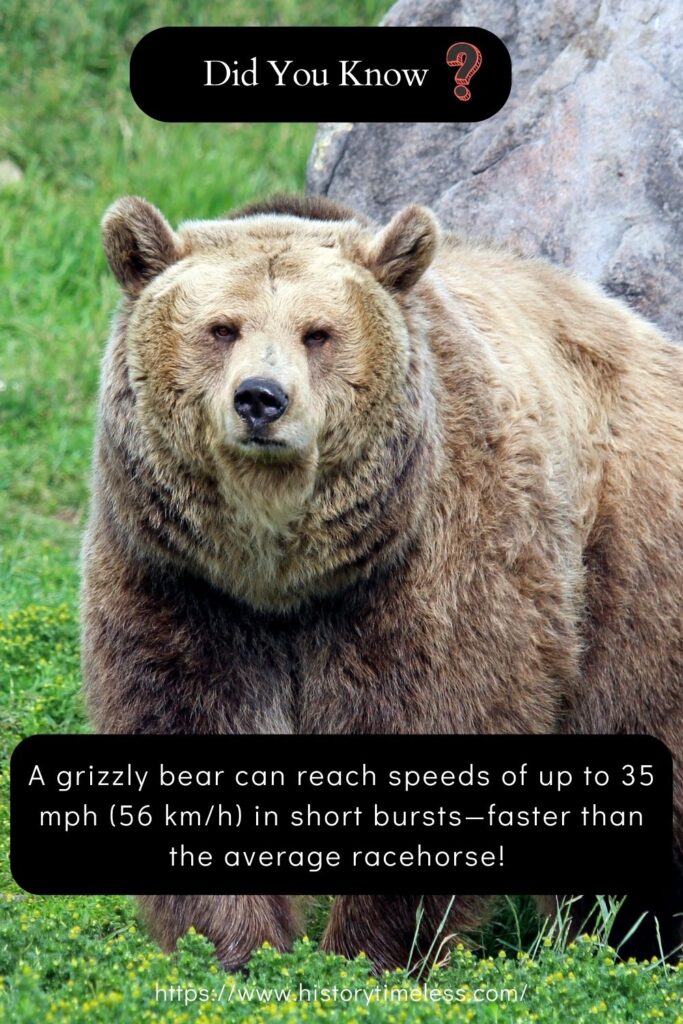Bears are some of the most captivating creatures on Earth, known for their strength, intelligence, and unique behaviors. From the mighty polar bear to the playful black bear, these animals have fascinated humans for centuries.
Whether it’s their surprising agility, complex social behaviors, or incredible survival skills, bears never fail to amaze.
In this blog, we’ll explore 28 incredible facts about bears that will leave you in awe of these magnificent mammals.
1. Bears Have an Incredible Sense of Smell
Bears possess one of the most powerful noses in the animal kingdom. A polar bear, for example, can detect a seal’s breathing hole from nearly a mile away!
Their sense of smell is about seven times stronger than a bloodhound’s, helping them locate food, mates, and even danger from great distances.
This keen olfactory ability is crucial for survival, especially in dense forests or vast Arctic landscapes where visibility is limited.
2. Some Bears Can Run Faster Than Horses
Despite their bulky appearance, bears are surprisingly fast. A grizzly bear can reach speeds of up to 35 mph (56 km/h) in short bursts—faster than the average racehorse!

Black bears are also agile runners and climbers, making them formidable predators and adept escape artists. This speed, combined with their strength, makes them one of nature’s most efficient hunters and survivors.
3. Bears Walk Like Humans (Sometimes)
Bears are plantigrade, meaning they walk on the soles of their feet, just like humans. This gives them a distinctive, flat-footed gait.
However, they can also stand on their hind legs for better visibility or to appear more intimidating. While bears don’t walk upright all the time, this ability helps them scout for food, defend territory, or even wave in zoo environments!
4. A Bear’s Hibernation Isn’t True Sleep
Contrary to popular belief, bears don’t experience deep sleep during hibernation. Instead, they enter a state called torpor, where their metabolism slows dramatically, but they can still wake up if disturbed.
Remarkably, they don’t eat, drink, or excrete for months, surviving solely on stored fat. Some species, like pregnant females, even give birth during hibernation!
5. Bears Are Highly Intelligent
Bears exhibit advanced problem-solving skills and memory. They can remember food sources years later and even use tools, such as rocks to scratch themselves or sticks to dig.
Studies show that bears have cognitive abilities comparable to primates, making them one of the smartest land mammals. Their intelligence helps them adapt to changing environments and human interactions.
6. Polar Bears Have Black Skin
Under their thick, white fur, polar bears actually have jet-black skin. This adaptation helps them absorb more heat from the sun, keeping them warm in freezing Arctic temperatures.
Their fur isn’t truly white either—it’s translucent and reflects light, giving it a snowy appearance while providing camouflage in their icy habitat.
7. Bears Communicate Through Body Language
Bears use a complex system of postures, facial expressions, and sounds to communicate. A mother bear may “chuff” to reassure her cubs, while a dominant male might stand tall to assert dominance.
Subtle cues like ear position or paw swiping convey emotions ranging from curiosity to aggression, helping avoid unnecessary conflicts.
8. Sloth Bears Have a Unique Diet
Unlike most bears, sloth bears primarily eat insects—especially termites and ants. Their long, curved claws and flexible snouts help them dig into nests.
They can close their nostrils to avoid inhaling dust. They’re also one of the few bear species that carry their young on their backs!
9. Bears Have Been to Space
In 1967, two black bears named “Tuffy” and “Bruno” were launched into space by the U.S. Air Force as part of a biological experiment.
While they didn’t orbit Earth, their journey helped scientists study the effects of space travel on large mammals. Thankfully, both bears returned safely!
10. Panda Bears Have a “False Thumb”
Giant pandas have an elongated wrist bone that functions like a thumb, helping them grip bamboo stalks. This unique adaptation isn’t a true digit but acts as an opposable tool.

Showcasing evolution’s creativity. Despite being classified as carnivores, pandas eat almost exclusively bamboo.
11. Bears Can See in Color
Unlike many mammals, bears have color vision similar to humans. This helps them identify ripe fruits, distinguish threats, and navigate their environment more effectively.
Their eyesight isn’t as sharp as their sense of smell, but it’s far from poor—especially when spotting movement from a distance.
12. Cubs Are Born Extremely Small
A newborn bear cub can weigh less than a pound (about the size of a squirrel)! Polar bear cubs are especially tiny, measuring just 12 inches long at birth.
Despite their fragile start, cubs grow rapidly thanks to their mother’s rich milk, which is up to 33% fat in some species.
13. Bears Have Been Worshiped in Cultures Worldwide
From Native American tribes to ancient Norse mythology, bears have been revered as symbols of strength, wisdom, and protection.
The Ainu people of Japan even considered bears sacred, holding ceremonies to honor them. Many cultures believed bears had healing powers or connections to the spirit world.
14. A Bear’s Age Can Be Determined by Its Teeth
Scientists estimate a bear’s age by counting the rings in a cross-section of its teeth, similar to tree rings. Wear patterns also reveal diet clues—for example, a panda’s molars are flattened from crushing bamboo, while a polar bear’s are sharper for tearing meat.
15. Bears Rarely Attack Humans (Despite Myths)
Most bears avoid humans and attacks are exceptionally rare. When conflicts occur, it’s often due to surprise encounters or a mother protecting cubs.
Surprisingly, statistically, bees and dogs are far more dangerous to humans than bears! Proper food storage and calm behavior reduce risks significantly.
16. Some Bears Build “Nests” in Trees
Asian sun bears and black bears sometimes create leafy nests in tree canopies to rest, eat fruit, or escape predators. These nests, made by bending branches, resemble those of great apes and highlight the bear’s surprising arboreal agility.
Here are 5 more incredible bear facts to add to your list:
17. Bears Have a Special “Toe” for Climbing
Black bears and other tree-climbing species have semi-retractable claws that function like built-in crampons.
Their curved shape allows them to grip bark effortlessly, scaling trees at astonishing speeds—sometimes even descending headfirst like a squirrel! This adaptation helps them escape predators or reach honeycombs high in the treetops.
18. The Word “Bear” Comes from an Ancient Euphemism
The English word “bear” derives from the Proto-Germanic berô, meaning “the brown one.” Linguists believe this was a euphemism to avoid saying the creature’s true name in old European languages, as people feared invoking its spirit. The original term, h₂ŕ̥tḱos, survives in “Arctic” (land of the bears).
19. Bears Can Go Months Without Pooping
During hibernation, bears develop a fecal plug (called a “tappen”) made of intestinal secretions and undigested material.
This blocks waste until spring, allowing them to conserve energy and avoid leaving their dens. Remarkably, their bodies recycle urea into protein instead of excreting it!
20. Polar Bears Are Invisible to Infrared Cameras
Thanks to their dense fur and blubber, polar bears retain heat so efficiently that they barely emit body heat in infrared scans.
This makes them nearly invisible to thermal imaging—a perfect adaptation for sneaking up on seals in the Arctic’s freezing temperatures.
21. Bears Were Once Tiny
The earliest known bear, Dawn Bear (Ursavus elmensis), lived 20 million years ago and was the size of a small dog.
Over millennia, some species evolved into giants like the extinct Arctotherium, which stood 11 feet tall—making today’s bears seem modest by comparison!
22. Bears Have a “Sweet Tooth” and Can Detect Honey from Miles Away
Bears have an extraordinary ability to locate honey, thanks to their keen sense of smell. They can detect a beehive up to 5 miles (8 km) away!
While they endure stings to get to the sweet prize, their thick fur and loose skin protect them from most bee attacks. This love of honey inspired the famous Winnie-the-Pooh character!
23. Some Bears Use “Tools” to Hunt or Play
Certain bear species, like brown bears, have been observed using rocks or sticks to scratch themselves, dig for food, or even swat fish out of the water.
In captivity, bears have learned to stack objects to reach food, proving their problem-solving intelligence rivals some primates.
24. A Bear’s Roar Can Be Heard Over 2 Miles Away
When a bear vocalizes at full force, its deep, resonant growls can travel more than 2 miles (3.2 km) through dense forests.
This helps establish territory or warn rivals without physical confrontation. Surprisingly, mother bears also use soft grunts and hums to soothe their cubs.
25. Bears Have Been Trained to Ride Bikes and Dance (Unethically, Sadly)
In the past, bears were exploited in circuses and sideshows, forced to perform tricks like bicycle riding or “dancing” (which was actually a reaction to painful hot plates under their feet).
Thankfully, this cruel practice is now banned in most countries, and sanctuaries rescue these bears for rehabilitation.
26. The Largest Bear Ever Recorded Weighed Over 2,500 Pounds
The Alaskan Kodiak bear holds the record for the largest bear ever documented—a male weighing 2,500 lbs (1,134 kg) and standing 14 ft tall on its hind legs!
These giants are a subspecies of brown bear and live exclusively on Alaska’s Kodiak Archipelago, where abundant salmon fuels their massive size.
27. Bears Practice “Synchronous Reproduction” in Harsh Climates
Female polar bears have evolved a remarkable reproductive strategy called delayed implantation. After mating in spring, the fertilized egg doesn’t implant in the uterus until fall – and only if the mother has gained enough fat reserves.
This ensures cubs (usually twins) are born during winter hibernation when the mother can nurse them safely. The entire pregnancy lasts just 2 months of active development, one of nature’s most efficient reproductive adaptations to extreme environments.
28. Bear Saliva May Hold the Key to Human Medical Breakthroughs
Scientists are studying bear saliva, which contains powerful antibacterial compounds that prevent infection despite their messy eating habits. Even more astonishing – during hibernation, bears produce a unique substance that prevents blood clots and maintains muscle mass despite months of inactivity.
Researchers believe unlocking these biological secrets could lead to revolutionary treatments for human conditions like osteoporosis, diabetes, and even space travel-related muscle atrophy.
Access further gripping facts:
30 Shocking Facts About America That Sound Fake!
25 Epic Facts That Will Leave You Stunned!
20+ Insane Facts About Animals That Defy Belief!
15+ Interesting World Facts: Say ‘Wow’ to These Discoveries!





